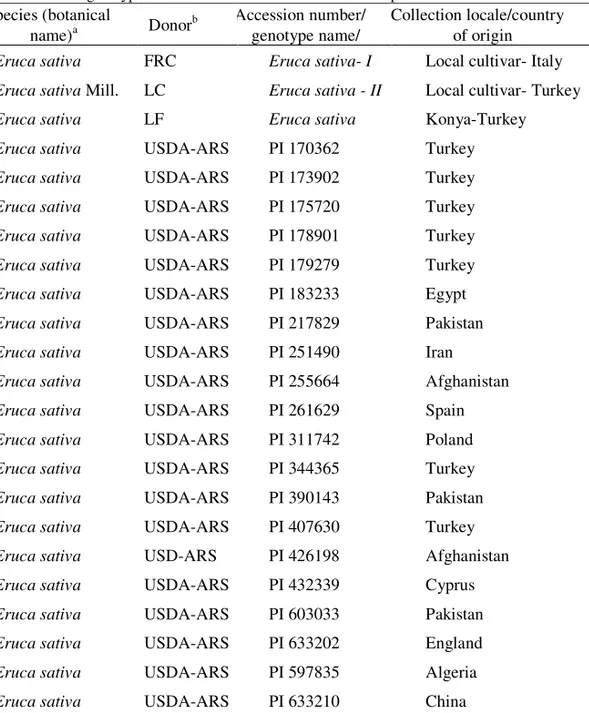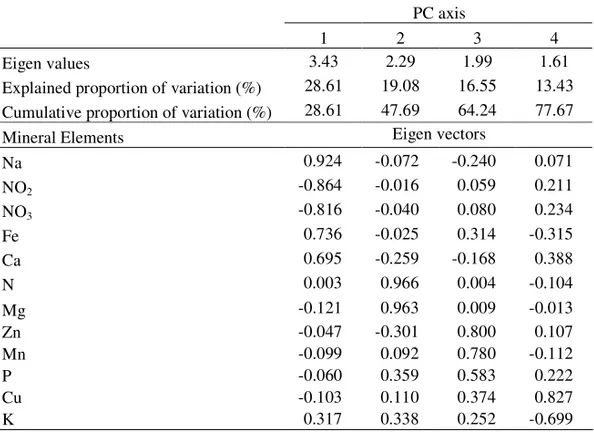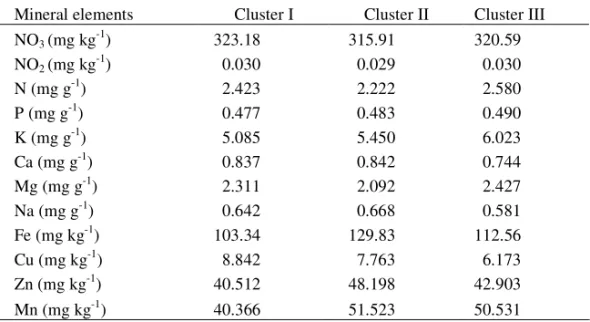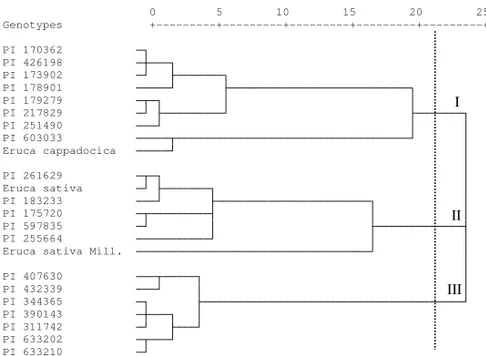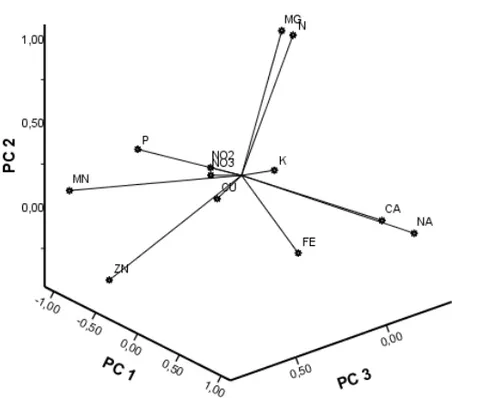____________________________
Corresponding author: M. Kadri Bozokalfa, Department of Horticulture, Faculty of Agriculture, Ege University, Bornova 35100 zmir, Turkey,Tel & Fax: +90 232 3881865, e-mail: mehmet.kadri.bozokalfa@ege.edu.tr
UDC 575:634 DOI: 10.2298/GENSR1103437B
Original scientific paper
USE OF MULTIVARIATE ANALYSIS IN MINERAL ACCUMULATION OF ROCKET (ERUCA SATIVA) ACCESSIONS
M. KADRI BOZOKALFA*1, Dursun E IYOK1, Bülent YA MUR2
1
Department of Horticulture, Faculty of Agriculture, Ege University, zmir, Turkey
2
Department of Soil Science, Faculty of Agriculture, Ege University, zmir, Turkey
Bozokalfa Kadri M., D. Esiyok, and B. Yagnur (2011): Use of multivariate analysis in mineral accumulation of rocket (eruca sativa) accessions.- Genetika, Vol 43, No.3, 437-448.
explained that 77.67% of total variation accounted for four PC axis. Rocket accessions were classifies into three groups and present outcomes of experiments revealed that the first three principal components were highly valid to classify the examined accessions and separating mineral accumulations. Significant differences exhibited in mineral concentration among examined rocket accessions and the result could allow selecting those genotypes with higher elements.
Key words: diversity, mineral accumulation, multivariate analysis rocket plant
INTRODUCTION
Green leafy vegetable E. sativa is member of Brassicaeae family and originated from Mediterranean countries. Rocket is much appreciated vegetable in Europe, North America, Argentina and South Africa, and also it has been cultivated in Central and Western Asia for seed oil (YANIV et al., 1998). The linseed oil which is produce from rocket and Linum usitatissimum seeds started thousands year ago in Central Anatolia (ERTUG, 2000) for use in lambs, to lubricate wooden-wheeled carts and in the processing of water-buffalo skins. The rocket plants are use in several ways as condiment in salads, spice, cooked vegetables and functional plants (KIM et al., 2006).
There is increasing interest for potential nutritional composition of vegetables effect on human health and the role in metabolic function in diet. Thus, researchers have been interested in improving the nutritional quality of plants, with respect to both nutrient composition and concentration (BOUIS, 1996). In this respects Brassicae family is substantial role in human diet and represents high amount of vitamin C, carotenes, phenolic compound and health promoting compound such as glucosinolates (D’ANTUONO et al., 2008). In addition Brassicae family rich sources of bioactive compounds which has chemoprotective properties such as glucosinolates, flavonoids, fiber, folate and carotenoids (JINet al., 2009). Although rocket plant is not considerable significant economic value comparing to the other Brassicae vegetables, consumption and growing areas is increase due to containing high mineral elements (E IYOK et al., 2010), observed potential health promoting compound, and it’s easy to grown year around with low cost value. The rocket plant is also containing high amount of vitamin C, glucosinolates, flavonoids and phenolic compound (MARTINEZ-SANCHEZ et al., 2006) and also rich in mineral elements (KAWASHIMA and VALENTE-SOARES 2003).
identify germplasm with high levels of the micronutrients in selection program to enhance the nutritional composition of species through the conventional plant breeding. Genetic diversity is imply the variability of species and can improve quality of cultivated plants (MILOSEVIC et al., 2010). Thus, it is important to assessment germplasm with high mineral concentration and application multivariate methods of analysis could be useful tool to selecting genotype (SANTOS et al., 2010) among plant genetic resources which is a good source for comprehensive breeding program.
The present research was undertaken to assess the degree of diversity in the mineral accumulation of genetically diverse rocket plant population using multivariate analyses.
MATERIALS AND METHODS
The study was conducted at the Ege University, Faculty of Agriculture, Department of Horticulture in Bornova, Izmir, Turkey. To determine genetic variation of mineral accumulation 23 accessions of rocket which 20 had been obtained from the USDA-GRIN (originating from several regions of the world), one sample of E. sativa, gathered from a market in the East of Turkey, and one E. sativa Mill. cultivar from Italy (Table 1). Seeds were sown in a 20 liter volume pots, containing a mixture of peat and perlite (3:1 v/v) as substrate and randomized complete block design were applied with three replications. A total 30 seeds were sown in each pot and trimmed after true leaves expansion and allowing 10 plants per pot. No chemical fertilizer, fungicide and insecticide were applied during cultivation, and weeds were controlled mechanically by hand until the plant reached harvest maturity. Plant samples were harvested by hand at leaves fully matured and ready for edible use.
In the experiment each accession leaf samples in analyzed in triplicate and 12 traits were recorded (NO2, NO3,N, P, K, Ca, Mg, Na, Fe, Cu, Zn, Mn). The total
amounts of NO3, NO2 and N in the leaf samples were determined by modified
Kjeldahl method, P in wet digested samples with colorimetry, potassium K, Ca and Na, with flame photometry, Mg, Fe, Zn, Cu and Mn using atomic absorption spectrometry.
Table 1. List of genotypes used for determination of mineral composition
Species (botanical
name)a Donor
b Accession number/
genotype name/
Collection locale/country of origin
Eruca sativa FRC Eruca sativa- I Local cultivar- Italy
Eruca sativa Mill. LC Eruca sativa - II Local cultivar- Turkey
Eruca sativa LF Eruca sativa Konya-Turkey
Eruca sativa USDA-ARS PI 170362 Turkey
Eruca sativa USDA-ARS PI 173902 Turkey
Eruca sativa USDA-ARS PI 175720 Turkey
Eruca sativa USDA-ARS PI 178901 Turkey
Eruca sativa USDA-ARS PI 179279 Turkey
Eruca sativa USDA-ARS PI 183233 Egypt
Eruca sativa USDA-ARS PI 217829 Pakistan
Eruca sativa USDA-ARS PI 251490 Iran
Eruca sativa USDA-ARS PI 255664 Afghanistan
Eruca sativa USDA-ARS PI 261629 Spain
Eruca sativa USDA-ARS PI 311742 Poland
Eruca sativa USDA-ARS PI 344365 Turkey
Eruca sativa USDA-ARS PI 390143 Pakistan
Eruca sativa USDA-ARS PI 407630 Turkey
Eruca sativa USD-ARS PI 426198 Afghanistan
Eruca sativa USDA-ARS PI 432339 Cyprus
Eruca sativa USDA-ARS PI 603033 Pakistan
Eruca sativa USDA-ARS PI 633202 England
Eruca sativa USDA-ARS PI 597835 Algeria
Eruca sativa USDA-ARS PI 633210 China
a
According to ARS-GRIN sample seed package information b
RESULTS AND DISCUSSION
A total twenty three accession was evaluated based on mineral accumulating in leaves and there were highly significant differences in all the mineral composition among the examined accessions. Many accession observed large amount of important mineral element for human nutrition particularly in K, Mn, Zn, and Cu concentrations. In order to evaluate mineral accumulation among E. sativa accessions in a diversity context principal component analysis were apply by all the twelve variables. The principal component analysis accounted for more than 77.67% of total variation encountered and four PC axes extracted in total variation, and the first three components was 64.24% in examined plant populations (Table 2). The first PC accounting for 28.61% of the variation comprises Na, NO2, NO3, Fe and
Ca. The second component emphasized N and Mg and accounted for 19.08% of the variation. The third component accounted for 16.55% of the total variation and concerned with Zn, Mn and P. The fourth component constituted 13.43% of the variation and Cu and K are characters contribute to fourth axes.
Table 2. Eigen values proportion of variability and minerals contributed to the first four PC’s of E. sativa accessions.
PC axis
1 2 3 4
Eigen values 3.43 2.29 1.99 1.61
Explained proportion of variation (%) 28.61 19.08 16.55 13.43
Cumulative proportion of variation (%) 28.61 47.69 64.24 77.67
Mineral Elements Eigen vectors
Na 0.924 -0.072 -0.240 0.071
NO2 -0.864 -0.016 0.059 0.211
NO3 -0.816 -0.040 0.080 0.234
Fe 0.736 -0.025 0.314 -0.315
Ca 0.695 -0.259 -0.168 0.388
N 0.003 0.966 0.004 -0.104
Mg -0.121 0.963 0.009 -0.013
Zn -0.047 -0.301 0.800 0.107
Mn -0.099 0.092 0.780 -0.112
P -0.060 0.359 0.583 0.222
Cu -0.103 0.110 0.374 0.827
K 0.317 0.338 0.252 -0.699
are given table 3, first cluster comprises nine accessions and showed the highest NO2
(323.18 mg kg-1), Ca (0.837 mg g-1), and Cu (8.842 mg kg-1), whilst lower P (0.477 mg g-1), K (5.085 mg g-1), Fe (103.34 mg kg-1), Zn (40.512 mg kg-1) and Mn (40.366 mg kg-1) concentration. The second cluster consist of seven accessions and the highest Na (0.668 mg g-1), Fe (129.83 mg kg-1), Zn (48.198 mg kg-1), Mn (51.52 mg g-1) and while the lowest NO3 (315.91 mg kg
-1
), NO2 (0.029 mg kg -1
), N (2.222 mg g
-1
), Mg (2.427 mg g-1). The highest N (2.580 mg g-1), P (0.490 mg g-1), K (6.023 mg g-1), Mg (2.427 mg g-1) obtained from third cluster and seven accessions was placed. The high total variance explained by the first three axes which observed 64.24% of the total variation and the major part of variance of the data set comes to lie on the first, second and third axes. In order to demonstrate relationships of investigated minerals the first three principal co-ordinates are given 3D (dimension) scatter plot (Figure 2). Mineral elements separate their corresponding value of explained proportion of variation in the scatter plot.
Table 3. Mean values for five clusters based on twelve mineral elements
Mineral elements Cluster I Cluster II Cluster III
NO3 (mg kg -1
) 323.18 315.91 320.59
NO2 (mg kg -1
) 0.030 0.029 0.030
N (mg g-1) 2.423 2.222 2.580
P (mg g-1) 0.477 0.483 0.490
K (mg g-1) 5.085 5.450 6.023
Ca (mg g-1) 0.837 0.842 0.744
Mg (mg g-1) 2.311 2.092 2.427
Na (mg g-1) 0.642 0.668 0.581
Fe (mg kg-1) 103.34 129.83 112.56
Cu (mg kg-1) 8.842 7.763 6.173
Zn (mg kg-1) 40.512 48.198 42.903
Mn (mg kg-1) 40.366 51.523 50.531
information is available mineral concentration levels in vegetables and have achieved only little concern in diversity context. Moreover multivariate analysis was not applied to assessment diversity context in the mineral concentration among rocket germplasm, yet.
Figure 1. Genetic relationship among 23 accessions of E. sativa based on mineral elements by Ward’s clustering method.
Principal component analysis and hierarchical clustering pattern which is comprises multivariate analysis has been apply in order to evaluate characterize and classify germplasm based on mineral composition in several species. This study focused on evaluating rocket germplasm mineral concentration by multivariate techniques to bring into the open information on differentiation among population for further breeding programme. In the present paper showed that significant differences in mineral concentration among examined rocket plant collections. The results of experiments revealed that the first three principal components were highly valid to classify the examined accessions and separating mineral accumulations. Mineral concentration, accumulation, and nutritional composition in edible of parts vegetables such as onion (Allium cepa L.) (CHOPE and TERRY 2009), kale (Brassica oleracea L. var. acephala DC.) (FADIGAS et al., 2010), common bean (Phaseolus vulgaris L.) (SANTOS et al., 2010) were investigated in diversity context and showed a wide variability among investigated genotypes. In addition ANDRE et al., (2007) showed a wide variability in micronutrient levels among the genetically diverse potato (Solanum tuberosum L.) core collection and indicate genetic differences in the control of these components.
0 5 10 15 20 25 Genotypes +---+---+---+---+---+
PI 170362 PI 426198
PI 173902
PI 178901
PI 179279
PI 217829
PI 251490
PI 603033
Eruca cappadocica
PI 261629
Eruca sativa
PI 183233
PI 175720
PI 597835
PI 255664
Eruca sativa Mill.
PI 407630
PI 432339
PI 344365
PI 390143
PI 311742
PI 633202 PI 633210
I
II
Figure 2. Patterns of relationships among E. sativa accession due to the first three principal co-ordinates.
DIZUDA and PITURA (2008) reported that nutritional value, chemical composition of plant tissue may greatly vary depending on the cultivation, fertilization. While soil mineral concentration, availability, fertilization and environment may influenced on nutrient accumulation in plant tissue, genetic variability is considerable influenced on mineral composition of plant. In present investigation plants were grown in same growing condition and same cultivation practices were apply in all pots and great variability was determined among accessions. The parts of variation could be explained by genotypic variation which is underlined among wild and cultivated rocket plant germplasm (BOZOKALFA et al., 2009). Mineral concentration differences among Brassica rapa L. accessions was also underlined by WU et al., (2007) and explained with genetic variation. Furthermore genetic variation in mineral accumulation in edible part of onion, kale, turnip, common bean, rice, and cabbage was assessed by several researchers (CHOPE and TERRY, 2009; FADIGAS et al., 2010; SANTOS et al., 2010; GREGORIO et al., 1999; HARRISON and BERGMANN (1981). Moreover BUKHSH et al., (2007) underlined that nutrient element compositions may vary due to botanical structures of plant. JIN et al., (2009) reported that plant growth condition and postharvest storage conditions have an impact on the range and quantity of phytonutrients accumulated and variability indicated among genotype.
or mineral deficiencies in developing countries by improving mineral concentration of edible part of vegetables. Increasing the contents of nutrition in plant food through plant breeding was proposed as a strategy for combination widespread mineral deficiencies. Therefore identification nutritionally rich germplasm could be enhancing the success of breeding program. Genotypic selection may reduce dietary micronutrient deficiencies (WELCH et al., 2000) and also selection specific cultivar among species would be help increasing elemental delivery in the human diet (KOPSELL et al., 2004). The rocket plant contains various health benefit compounds such as thiocyanates and isothiocyanates, in addition due to their glucosinolates composition the plant could be classifies as a functional foods (SLATER and MANVILLE 1993; MILAN et. al., 1996). Furthermore it has a potential to become oil crop in Turkey (BOZOKALFA et al., 2010). The present research underlined that rocket plant accumulate large amount of mineral element and exhibited great variability which could be explanation by genotypic variation among accessions. Having this in mind and banking on available expertise examined germplasm are good source for future breeding programme either for mineral concentration and nutritive value.
Received, January 10th , 2011 Accepted, November17th
, 2011
REFERENCES
AHMED, H., M.K. KHALIL, A.M. FARRAG (2000): Nitrate Accumulation, growth, yield and chemical composition of Rocket (Eruca vesicaria subsp. Sativa) plant as affected by NPK fertilization, kinetin and salicylic acid. ICEHM2000, Cairo University, Egypt, pp 495- 508.
ANDRE, C. M. M. GHISLAIN, P. BERTIN, M. OUFIR, M.R. HERRERA, L. HOFFMAN, J.F. HAUSMAN, Y.
LARONDELLE, D. EVERS (2007): Andean potato cultivars (Solanum tuberosum L.) as a source of ntioxidant and mineral micronutrients. J. Agric. Food Chem. 55, 366–378.
BORAH, S., A.M. BARUAH, A.K. DAS, J. BORAH (2009): Determination of mineral content in commonly consumed leafy vegetables. Food Anal. Method 2, 226-230.
BOUIS, H.E. (1996): Enrichment of food staples through plant breeding: a new strategy for fighting micronutrient malnutrition. Nutr. Rev. 54, 131–137.
BOZOKALFA M.K., B.YA MUR, H. ILBI, D. E IYOK, S. KAVAK (2009): Genetic variability for mineral concentration of Eruca sativa L. and Diplotaxis tenuifolia L. accessions. Crop Breed. Appl. Biot. 9, 372-381
BOZOKALFA M.K., D. E IYOK, H. ILBI, T. KAYGISIZ A ÇIO UL (2010): Estimates of genetic variability and association studies in quantitative plant traits of Eruca spp. Landraces. Genetika 42, 501-512.
BUKHSH, E., S.A. MALIK, S.S. AHMAD (2007). Estimation of nutritional value and trace elements content of Carthamus oxycantha, Eruca sativa and Plantago ovata. Pak. J. Bot. 39, 1181-1187.
CHOPE, G.A., L.A. TERRY (2009): Use of canonical variate analysis to differentiate onion cultivars by mineral content as measured by ICP-AES. Food Chem. 115, 1108–1113.
DZIDA, K., K. PITURA (2008): The influence of varied nitrogen fertilization on yield and chemical composition of swiss chard (Beta vulgaris L. var. cicla L.). Acta Sci. Pol. Hortorum Cultus 7, 15-24.
ERTUG, F (2000): Linseed oil and oil mills in Central Turkey flax/linum and eruca important oil plant of Anatolia. Anat. Stud. 50, 171-185.
E YOK, D., M. K. BOZOKALFA, B. YA MUR, T. KAYGISIZ A ÇIO UL (2010): Nutrional value and economic plant properties of E. sativa accessions. Cruciferae Newslet. 29, 42-45.
FADIGAS, J.C., A.M.P DOS SANTOS, R.M. DE JESUS, D.C. LIMA, W.D. FRAGOSO, J.M. DAVID, S.L.C. FERREIRA
(2010): Use of multivariate analysis techniques for the characterization of analytical results for the determination of the mineral composition of kale. Microchem. J. 96, 352–356.
GREGORIO, G.B., D. SENADHIRA, H. HTUT, R.D. GRAHAM (1999): Improving micronutrient value of rice for human health, in: Improving human nutrition through agriculture: the role of international agricultural research. A workshop hosted by the International Rice Research Institute, Los Banos, Philippines and organized by the International Food Policy Research Institute, 5-7 October 1999.
HARRISON, H.C., E.L. BERGMAN (1981): Calcium, magnesium, and potassium interrelationships affecting cabbage production. J. Amer. Soc. Hort. Sci. 106, 500-503.
JIN, J., O.A. KOROLEVA, T. GIBSON, J. SWANSTON, J. MAGAN, Y. ZHANG, I.R. ROWLAND, C. WAGSTAFF
(2009): Analysis of Phytochemical Composition and Chemoprotective Capacity of Rocket (Eruca sativa and Diplotaxis tenuifolia) Leafy Salad Following Cultivation in Different Environments. J. Agric. Food Chem. 57, 5227-5234.
KADER, A.A. (2008): Flavor quality of fruits and vegetables. J. Sci. Food Agr. 88, 1863–1868.
KAWASHIMA, L.M., L.M. VALENTE-SOARES (2003): Mineral profile of raw and cooked leafy vegetables consumed in southern Brazil. Food Compos. Anal. 16, 605:611.
KIM S.J., C. KAWAHARADA, G. ISHII (2006): Effect of ammonium nitrate nutrient ratio on nitrate and glucosinolate contents of hydroponically-grown rocket salad (Eruca sativa Mill.). Soil Sci. Plant Nutr. 52, 387–393.
KOPSELL, D.E., D.A. KOPSELL, M.G. LEFSRUD, J. CURRAN-CELANTANO (2004): Variability in elemental accumulations among leafy Brassica oleracea cultivars and selections. J. Plant Nutr. 27, 1813-1826.
MARTINEZ-SANCHEZ, A., A. MARIN, R. LLORACH, F. FERRERES, M.I. GIL (2006): Controlled atmosphere preserves quality and phytonutrients in wild rocket (Diplotaxis tenuifolia). Postharvest Biol. Technol. 40, 26–33.
MILAN, S.C., E. TAUBE, R. BATTAGLIA (1996): Identification of Bis (4-isothiocyanatobutyl) Disulfide and Its Precursor from Rocket Salad (Eruca sativa). J. Agric. Food Chem., 44, 3835–3839.
MILOSEVIC, M., M. MILORADOV, S. DRAGIN, M. STEGIC (2010): The importance and implication of genetic resources in agriculture. Genetika 42, 585-598.
SANTOS, S.C., P.H. FERRI, M.R. SANTOS, L.C. FARIA, P.I. OLIVEIRA, M.D.T. THUNG (2010): Multivariate characterization of bean varieties according to yield production, mineral and phenolic contents. J. Braz. Chem. Soc. 21, 1917-1922.
SLATER, G.P., J.F. MANVILLE (1993): Analysis of thiocyanates and isothiocyanates by ammonia chemical ionization gas chromatography-mass spectrometry and gas chromatography-Fourier transform infrared spectroscopy. J. Chromatogr. 648: 433.
WELCH, R.M., W.A. HOUSE, S. BEEBE, D. SENADHIRA, G. GREGORIO, Z. CHENG (2000): Testing iron and zinc bioavaliability in genetically enriched bean (Phaseolus vulgaris L.) and rice (Oryza sativa L.) using a rat model. Food Nutr. Bull. 21, 428–433.
WU, J., H. SCHAT, R. SUN, M. KOORNNEEF, X. WANG, M.G.M. AARTS (2007): Characterization of natural variation for zinc, iron and manganese accumulation and zinc exposure response in Brassica rapa L. Plant Soil 291, 167–180.
ANALIZA AKUMULACIJE MINERALA U RAZLI ITIM GENOTIPOVIMA
ERUCA SATIVA
M. KADRI BOZOKALFA*1,Dursun E IYOK1 ,Bülent YA MUR2
1
Odelenje za Hortikulturu, Poljoprivredni fakultet Ege Univerziteta, Izmir, Turska
2
Odelenje za izu avanje zemljišta, Poljoprivredni fakultet Ege Univerziteta, Izmir, Turska
I z v o d
Lisnato povr e, uklju uji i i kupusnja e sadrži veliku koli inu mineralnih elemenata i komponenata zna ajnih za zdravlje. Rešenju problema dijete i nepravilne ishrane ljudske populacije pomogla bi selekcija genotipova specifi nog kvaliteta unutar biljne vrste. Iako kupusnja e sadrže nekoliko hranljivih elemenata nisu vršena istraživanja geneti ke divergentontnosti mineralnog sastava liš a primenom metoda analize multiple variance. Predmet ovih istraživanja je utvr ivanje varijabilnosti akumulacije minerala u razli itim genotipovima analizom varijanse u cilju oplemenjivanja na visok sadržaj hranljivih elemenata. Vršena su ispitivanja sadržaja dvanaest minerala u dvadeset tri genotipa Eruca sativa. Utvr ene su statisti ki zna ajne razlike izme u ispitivanih genotipova. Genotipovi su klasifikovani u tri grupe i rezultati analize multiple varijanse su pokazali da su prve tri glavne komponente variranja visoko zna ajne za klasifikaciju ispitivanih genotipova prema akumulaciji minerala. Zna ajne razlike utvr ene izme u genotipova u koncentraciji minerala omogu uju odabiranje onih sa visokim sadržajem ispitivanih mineralnih elementa.
Primljeno, 10.I. 2011.
